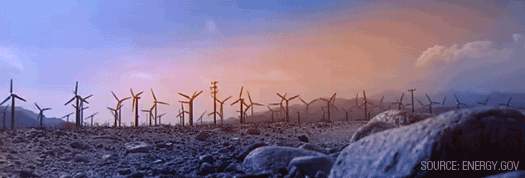Wind energy takes advantage of the kinetic energy in moving air (wind), to turn large blades connected to a central hub. The blades (called rotors) are often made of fibre-glass, designed to be aerodynamic and are mounted on a tower. Larger rotors have a larger ‘swept area’ and produce more energy than shorter rotors. With wind action, the rotors turn shafts inside the hub (which is made of metals, magnets and wires), which converts produces electricity. The electricity is then delivered to the main power grid, which is further released for consumption.
The movement of rotors look a bit slow to generate any power, in fact, they average about 18 revolutions per minute. However, the rotor shafts are connected to a series of gears that increase the rotations to about 1,800 per minute, making it reasonable speed to produce power.
Wind energy has some peculiar problems. First, it is only successful in locations with stable winds, even though engineers are working on new blade designs and models that can still be effective during low winds. Too much wind also cause problems of breaking the fans. Spinning blades from wind energy farms are also a concern, as they pose a danger to wildlife and disrupt landscapes. But the advantages far outweigh the problems and make it a worthwhile resource to have.

Wind energy is becoming very popular. In 2011, about 11 million homes in the USA were powered by this kind of energy. An estimated 3,464 turbines were installed across the USA, indicating a rapid growth in wind energy production. The United States and China together accounted for nearly 60% of the global market in 2012, followed distantly by Germany, India, and the United Kingdom (REN2, Global Status Report, Renewables 2013)
Farms and homeowners can take advantage of a single installed system to support their regular energy sources. In fact, this technology is not entirely new. Many years ago, they were used on farms to mill grains and farm products.
Energy companies install many of the units (called a wind plant) that capture all the energy in one location. Sometimes they are combined with solar cell systems (photovoltaic), where they are then distributed to customers.
